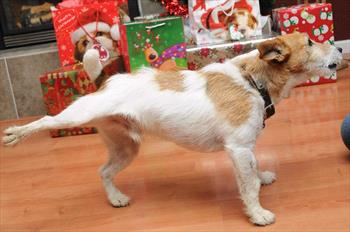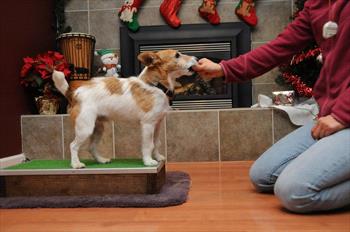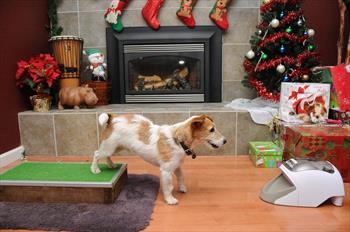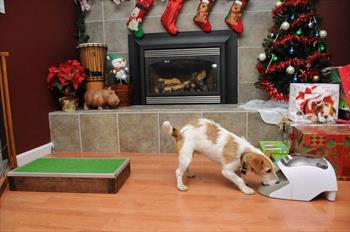Martial arts is handy for any dog interested in participating in action flicks and Jack Russell Christmas Specials.
But even if you’re not a black belt in karate, you can still learn a basic karate kick.
Here’s how I learned it.
The key to this trick for me was figuring out that I was supposed to lift a hind leg. A clicker or some marker word that means a treat is coming is essential. My human had to click while I was lifting a hind leg, but the trick was that I had to be aware that I was lifting my hind leg. Otherwise I couldn’t perceive that the click was associated with that hind leg being raised. Here’s how I figured it out.
First, my human got me to stand on a platform by rewarding me on it. Actually I already knew how to stand on platforms upon hearing the cue word “place”…. Because I’m really smart.
Then she lured me to stand with 2 feet on and 2 feet off the platform and rewarded me with 5 or more sequential treats for staying in that position. She repeated these steps about 10 times so that I figured out that this position of 2 feet on and 2 off was a good position.
Next she started rewarding me with a Treat&Train® instead of by hand to get better timing in preparation for being able to focus on watching for a leg raise. The Treat&Train placement kept me looking forward while my human could move a little to the side so that she could easily see if I was raising my leg in later steps.
When I stood in the correct position, she’d press the remote control to dispense a treat from the Treat&Train.
Note in this step that I have to step off the platform to get a treat.
After I got off the platform I would want to get back in the 2-on and 2-off position, but sometimes I’d stand around and then my human would give me the cue to get onto the box. Now, some dogs are focused on doing exactly what they’re told. But I like to improvise and look for efficiency. I quickly figured out that a short cut for getting into position would be to back up onto the box. And that was the key!
You’ll see why in a sec.
Next, my human increased the height of the box, but let me get on front feet first a couple times. In real life, she used a shorter box before we graduated to this size.
Then she skipped to rewarding with the Treat&Train again so she could move into position to see what I was doing with my hind legs.
This time when I backed up, because I knew the box was pretty high, I lifted my leg higher and when I lifted, she clicked and rewarded with treats from the Treat&Train. That’s how I continued to know that it was correct to lift my leg. I didn’t have to actually get onto the box — I could tell I was getting rewarded for lifting the leg when near the box.
Next, she moved the Treat&Train further away. Whenever I raised my leg, she’d click and treat before I had a chance to back up all the way onto the box. So now, I knew that I didn’t have to be near the box to get rewards. I just needed to raise my leg.
Next she started rewarding only when I kicked my leg.
So you see, this trick is actually super easy when you have a human like mine who knows the basic principles of learning. Start by rewarding behaviors you can easily get and then reward behaviors closer and closer to your goal behavior. It only took me a couple of 5-minute sessions to learn this trick! That’s way shorter than the amount of time it took me to be calm around cats and chickens!!
BTW. If you want your human to learn the scientific principles and the techniques needed to teach you all kinds of tricks and useful behaviors this quickly and easily, you should get another human to give these DVDs to them as a gift! Skills for Handling Your Reactive or Hyperactive Dog Part One and Part Two.












